7 Steps to Promote Manufacturing Safety
Sep 01, 2021

Workplace safety is a top concern among manufacturers. Without taking COVID-19 into account, the National Institute for Occupational Safety and Health (NIOSH) estimates that occupations within the manufacturing sector account for 5% of U.S. workers, yet they represent 8% of all workplace fatalities.
Unfortunately, COVID-19 has added to the safety concerns that manufacturers face. At the start of the pandemic, manufacturers scrambled to implement safety measures to minimize viral spread and comply with social distancing restrictions imposed by state and local governments. As new variants continue to emerge, manufacturers must continually review their safety protocols.
Going forward, manufacturers may need to invest in new or improved safety measures to protect workers in the new normal. Here are seven protective measures that can help improve workplace safety.
1. Always Use Equipment Properly
The most frequent cause of workplace injuries is misuse of tools and machinery. So, it’s important to utilize equipment only for its intended purpose. Regularly cleaning and inspecting equipment reduces the possibility of a fire, explosion or injury. Employees should be trained on proper and safe equipment use.
2. Minimize the Risks of Slips and Falls
Take a walk through your factory and warehouse. Aisles should be clear and clutter-free. When spills happen, workers should clean them immediately. Anti-slip flooring, drip pans and/or guards should be installed wherever spills can’t easily be cleaned, especially for firms using liquids.
Even though your budget might be tighter than usual due to COVID-related cost-cutting measures, don’t skimp on maintenance. Remember to check your workplace floor for loose boards, holes and protruding nails.
3. Eliminate Fire Hazards
Are you in compliance with local fire codes? Be on the lookout for items blocking doorways and walkways — and remove them as soon as possible.
In addition, if you’re using combustible materials, keep only the amount needed for the job and store the flammable material in a safe site off-premises. Likewise, combustible waste should be stored in metal receptacles and thrown away daily.
4. Prevent Falling Objects
Nets, toe boards and toe rails should be used to safeguard workers against items falling from above. In your warehouse, heavy objects should be placed on lower shelves, and boxes should be stacked straight up and down.
5. Train Workers on Safe Lifting Protocols
Workers should be taught to lift objects properly to avoid injuries. When moving heavy objects, workers should use their legs to lift (rather than lifting the object straight up) and keep their backs straight (rather than stooping or twisting). Consider investing in dollies, forklifts and other machines to help workers hoist heavy objects.
6. Require PPE when Operating Machinery or Cleaning Up
Personal protective equipment (PPE) is especially important when dealing with hazardous materials. Under Occupational Safety and Health Administration (OSHA) regulations, PPE such as gloves, safety hoods and shoes, earplugs, hard hats, respirators, and full body suits are mandatory in certain situations. (See “When Do You Need PPE?” below.) Workers should always wear protective gear on the factory floor to reduce the potential for injury.
7. Analyze Your Risks
A comprehensive safety risk assessment can help spotlight ways to avoid accidents. If you don’t have the necessary inside resources, hire a professional to develop a risk assessment plan identifying the hazards associated with your particular operation. This will also determine risk levels, review safety and working condition of equipment, and recommend the necessary controls.
Win-Win Situation
Safety should be a high priority for employees and employers alike. From the employer’s perspective, creating a safe work environment is a matter of good corporate citizenship, and it can improve productivity by bolstering morale and minimizing downtime. Sidestepping key safety measures can be a costly mistake.
Costs incurred today to make your facilities safer will create goodwill and add value over the long run. Kirsch CPA Group can help evaluate investment alternatives, conduct a comprehensive safe risk assessment and explore tax breaks for implementing safety measures at your facilities.
Pack This 1-2 Tax Punch
Generally, safety materials — including additional cleaning and disinfectant supplies purchased during the pandemic — are currently deductible as ordinary and necessary business expenses.
Other major improvements to make your facilities safer — such as installing security cameras, toe boards or anti-slip flooring — must generally be capitalized and depreciated over time. Fortunately, there are two significant depreciation-related tax breaks for you to consider taking advantage of:
1. 100% first-year bonus depreciation deductions. For qualifying assets placed in service in 2021, business taxpayers can deduct 100% of the cost in the first year. The 100% immediate write-off is allowed for both new and used qualifying assets, which include most categories of tangible depreciable assets. The bonus depreciation program can potentially create or increase a net operating loss (NOL) for the year.
2. Section 179 deductions. For tax years beginning in 2021, a business taxpayer can potentially write off up to $1.05 million of the cost of qualifying new and used assets under the Sec. 179 deduction. Under a phaseout rule, the maximum $1.05 million Sec. 179 deduction for tax years beginning in 2021 is reduced dollar-for-dollar by the excess of Sec. 179 deduction-eligible asset additions over $2.62 million.
However, the allowable deduction for a tax year can’t exceed the taxpayer’s aggregate net business taxable income from all sources calculated before any Sec. 179 deductions. That means Sec. 179 deductions can’t create or increase a federal income tax NOL. Deductions that would create or increase an NOL are disallowed and carried forward to the following tax year.
Bonus depreciation and Sec. 179 deductions aren’t mutually exclusive and can be combined. It’s usually considered a tax-smart move to claim these tax breaks. Consult with your tax advisor to determine what’s best for your situation.
When Do You Need PPE?
According to the Occupational Safety and Health Administration (OSHA) regulations, personal protective equipment (PPE) is required in the following situations:
- Goggles or safety glasses must be worn by anyone operating machinery that may expose that person to flying particles.
- Protective eyewear must be worn by workers and bystanders in a laboratory with any form of chemicals, acids or caustic liquids, gases or vapors.
- Steel-toe boots are required in any environment where heavy materials may be dropped, or an individual’s foot could be run over by machinery.
- Gloves must be provided to workers when their hands may be exposed to cuts, abrasions or puncture wounds.
- Hand protection is required for exposure to extreme temperatures, chemical or thermal burns or harmful substances.
- Ear protection is required for any worker exposed to 85 decibels or more over the course of an eight-hour day. If noise levels reach 90 decibels, OSHA requires the employer to reduce the noise level or cut the time the worker is exposed to the noise.
- Hard hats are required whenever a worker is exposed to overhead objects that could fall and produce a head injury.
Arc flash suits are normally required only for use by electricians working in an area with a high potential for arc flash. However, others working where there’s potential for an event should wear protective clothing.
Contact us to learn more about promoting manufacturing safety
© Copyright 2021. All rights reserved.
Sign Up for Email Updates
Accounting & Financial News

Tax Law Changes: 10 Provisions Employers Need to Know
The One Big Beautiful Bill Act (OBBBA) includes a number of tax law changes that affect employers.…





